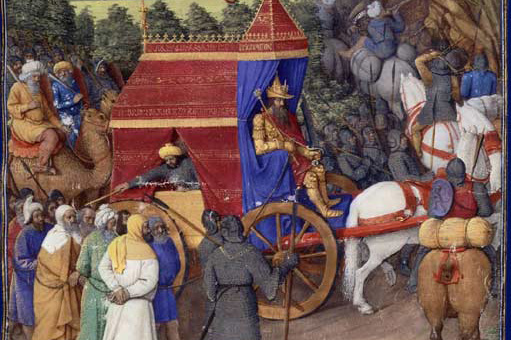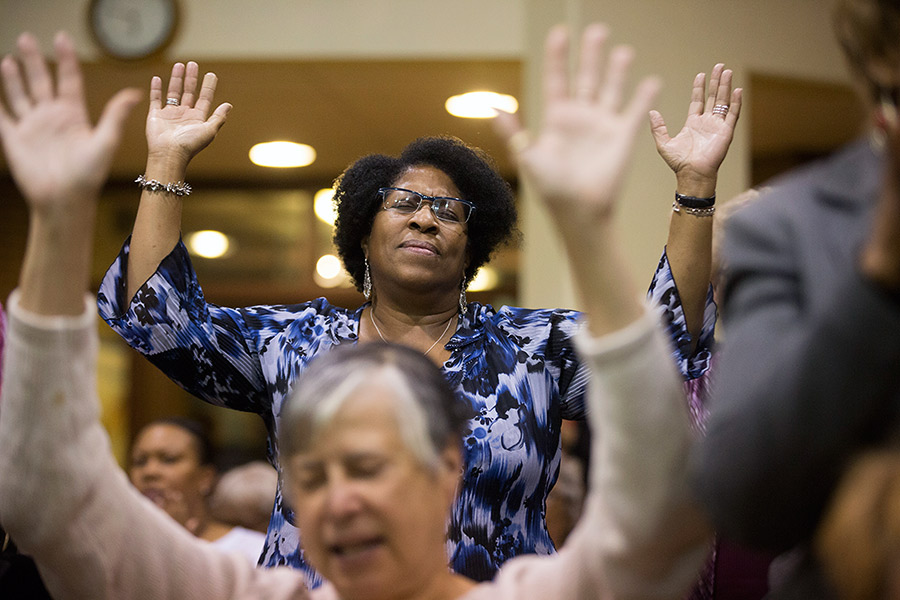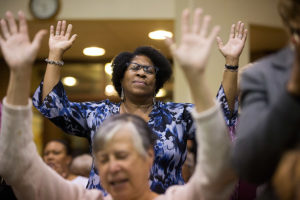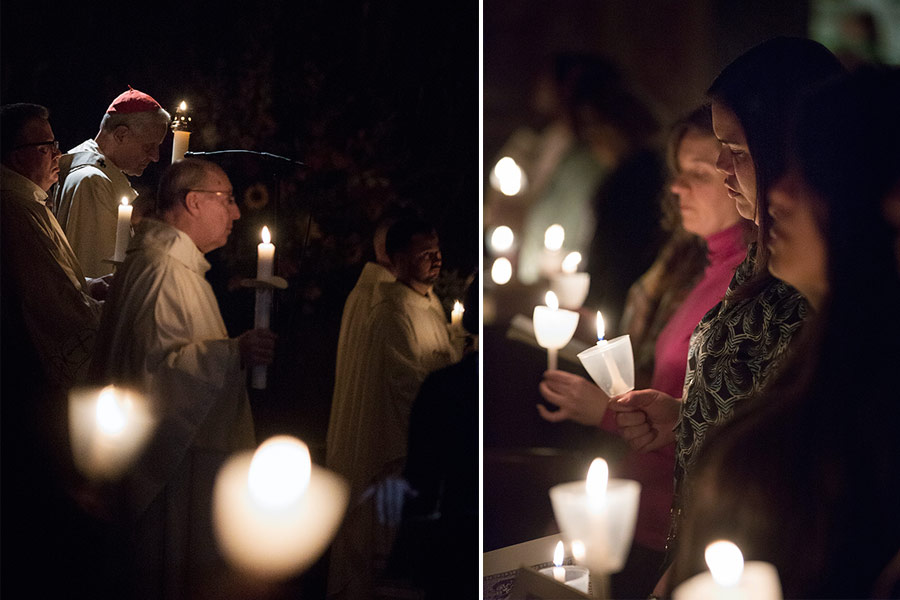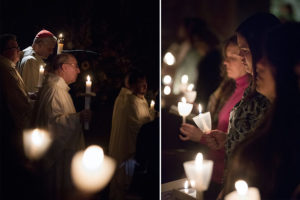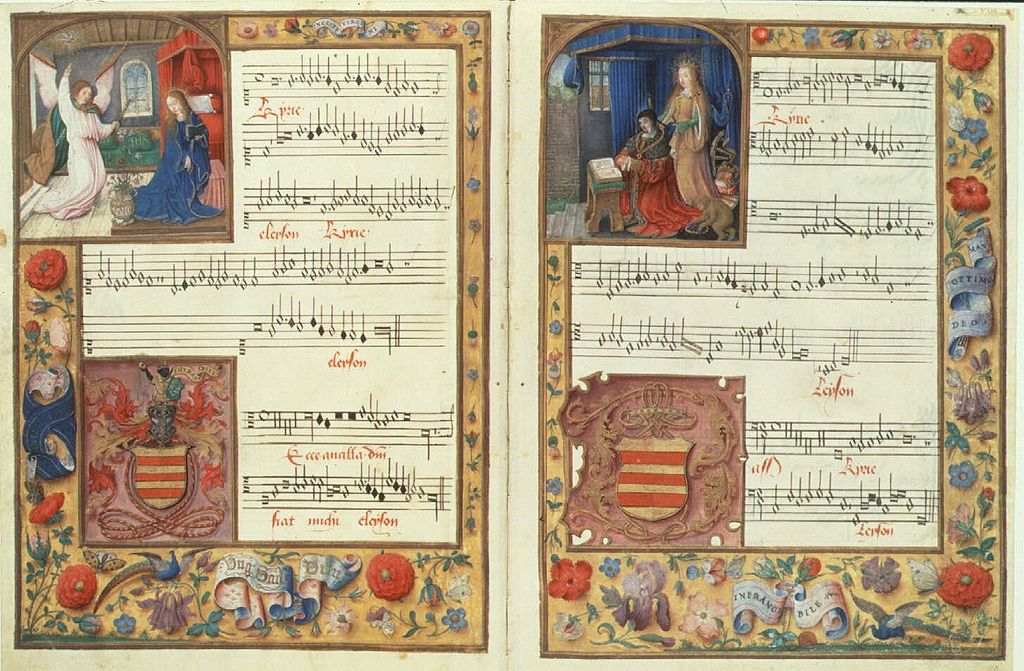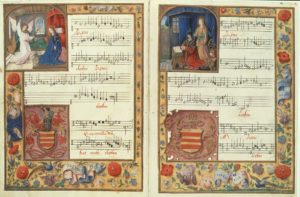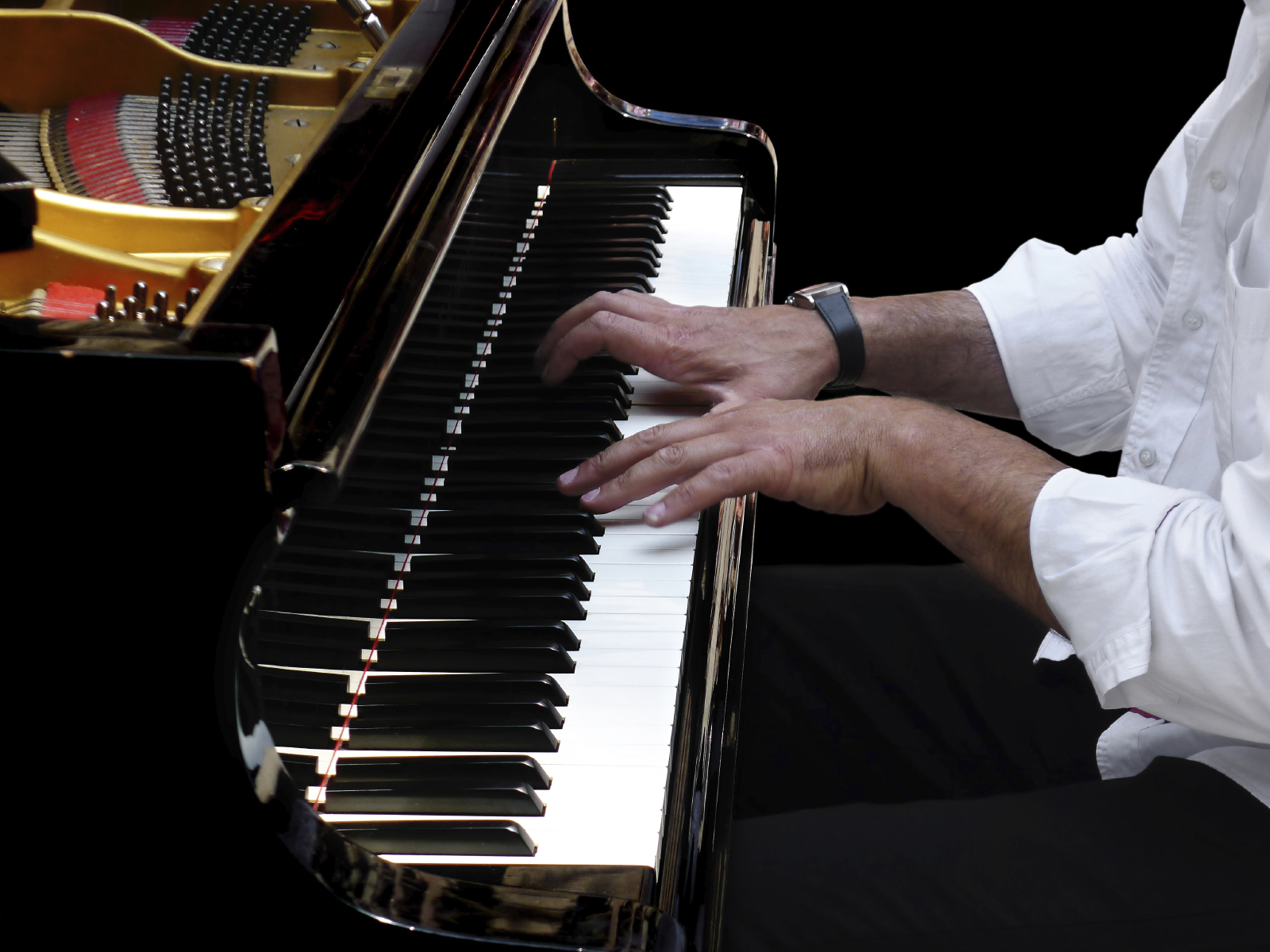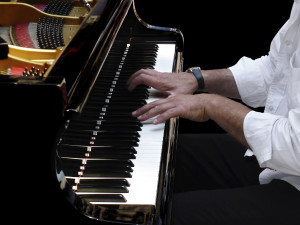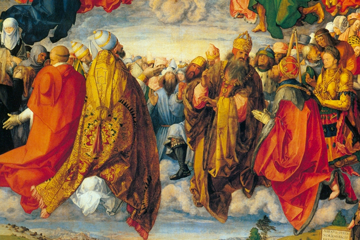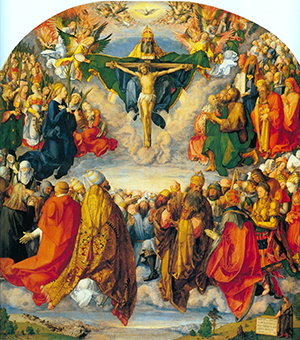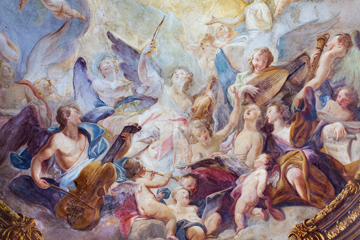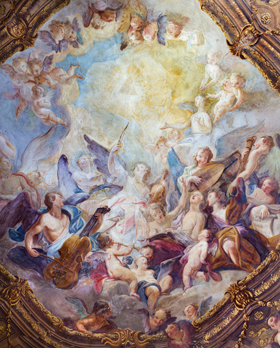 There is a story of King Jehoshaphat and the victory of Israel against the Moabites, Ammonites and Meunites (2 Chronicles 20). It is a story that speaks of the power of praise to defeat a numberless army. Simply singing a hymn of praise can cast out demons, avert war, and send evil threats limping away.
There is a story of King Jehoshaphat and the victory of Israel against the Moabites, Ammonites and Meunites (2 Chronicles 20). It is a story that speaks of the power of praise to defeat a numberless army. Simply singing a hymn of praise can cast out demons, avert war, and send evil threats limping away.
Yes, praise! It is not always weapons of iron and steal and fiery bombs that wins the day. Often it is simple praise, hands lifted in prayer, voices raised in praise.
Never underestimate the power of the liturgy to change world history, to turn back threats and see the devil’s power crushed. Indeed, scripture says, Through the praise of children and infants you have established a stronghold against your enemies, to silence the foe and the avenger (Psalm 8:2).
I would like to take a more detailed look at this passage from Second Chronicles to see what praise and communal prayer can do. As a Church musician myself, and now a priest, I have often used this text to speak to Church Choirs of the power of praise. For, in this text we see that it is the choir, not the army that wins the day! Lets look at the text.
I. THE ANXIETY PORTRAYED – We begin with a description of a looming Crisis. The text says, After this the Moabites and Ammonites, and with them some of the Meunites, came against Jehoshaphat for battle. Some men came and told Jehoshaphat, “A great multitude is coming against you from Edom, from beyond the sea; and, behold, they are in Hazazontamar” (that is, Engedi). Then Jehoshaphat feared, and set himself to seek the LORD, and proclaimed a fast throughout all Judah. (2 Chron 20:1-3)
Now all this may seem a bit remote to us moderns. Indeed it my sound more like recitation for an ancient atlas or recitations from a “Jewish telephone book.” Don’t let all the names and places distract you. You and I also face a triple threat from the world, the flesh and the devil; from sins, sorrows and sufferings or just that situation you’re going through!
Indeed, as a pastor I am keenly aware that many come into our parishes on Sunday fighting demons and enemies. Many are overwhelmed, discouraged and afraid. They seek wisdom from God through his word and Sacraments.
And we who would pastor and lead parishes must seek above all to make our parishes, and the celebration of our liturgies, healing moments for God’s people, moments that give them hope and victory over afflictions and demons and difficulties. It is much like the disciples on the road to Emmaus who, encountering the Lord, had their hearts set on fire and their path redirected toward the heavenly Jerusalem.
People come with burdens, and we must be a place of blessing, or instruction in the Lord and a place that reminds of victory to those who persevere. And thus it makes sense that we head to the next step where in the faithful are assembled to seek healing, blessing and victory.
II. THE ASSEMBLING OF THE PEOPLE – The text says, And Judah assembled to seek help from the LORD; from all the cities of Judah they came to seek the LORD. And Jehoshaphat stood in the assembly of Judah and Jerusalem, in the house of the LORD, before the new court, and said, “O LORD, God of our fathers, art thou not God in heaven? Dost thou not rule over all the kingdoms of the nations? In thy hand are power and might, so that none is able to withstand thee. Didst thou not, O our God, drive out the inhabitants of this land before thy people Israel, and give it for ever to the descendants of Abraham thy friend? And they have dwelt in it, and have built thee in it a sanctuary for thy name, saying, ‘If evil comes upon us, the sword, judgment, or pestilence, or famine, we will stand before this house, and before thee, for thy name is in this house, and cry to thee in our affliction, and thou wilt hear and save.’ And now behold, the men of Ammon and Moab and Mount Seir, whom thou would not let Israel invade when they came from the land of Egypt, and whom they avoided and did not destroy– behold, they reward us by coming to drive us out of thy possession, which thou hast given us to inherit. O our God, wilt thou not execute judgment upon them? For we are powerless against this great multitude that is coming against us. We do not know what to do, but our eyes are upon thee.” Meanwhile all the men of Judah stood before the LORD, with their little ones, their wives, and their children. (2 Chron 20:4-11)
Notice that the people all assemble: Men and women, young and old, children too. Here is sacred assembly and the power of communal prayer. Private prayer is both necessary and good. But there comes a time each week when all the faithful must assemble and join their collective prayers and praises. Here is a time of collective praise and, as we shall see of the sharing of wisdom and mutual support.
Isn’t this what we do each Sunday? We face demons and enemies and struggle with fear, just as did these people of old. But we, like them assemble and find strength. We tell the biblical and personal stories of how we’ve overcome and we draw strength from our story. Yes, there we are, clergy and people together with our God who instructs us in the battle reminds us of the victory, feeds us to strengthen us, and gives us a pledge of future glory in the Eucharist.
The Book of Hebrews says, And let us consider how to stir up one another to love and good works, not neglecting to meet together, as is the habit of some, but encouraging one another, and all the more as you see the Day drawing near. (Heb 10:24-25)
Note that in this ancient gathering Jehoshaphat and the people do four things. There is:
1. The PRAISE of POWER (OF GOD)- For they say: O LORD, God of our fathers, art thou not God in heaven? Dost thou not rule over all the kingdoms of the nations? In thy hand are power and might, so that none is able to withstand thee. (vv. 4-6). And this is very much what we do in the Gloria, our collects, and in the Preface of the Eucharistic Prayer. In praising the power of God we acknowledge his capacity to save us and are stirred to hope that He, who can make a way out of no way, will save us.
2. The PROCLAMATION of PAST DEEDS – For they recall that God settled them in this land as blessed them day by day. And they recall God’s promise to answer their prayer. And we too, as we read God’s word every Sunday of affliction, but then of deliverance. We learn that weaping ay endure for a night, but Joy does come with the morning light! This proclamation and reminder of God’s steadfast help in the past, steels our confidence that, as Scripture says, But this I will call to mind; therefore I will hope: The LORD’s mercy is not exhausted, his compassion is not spent; They are renewed each morning—great is your faithfulness! The LORD is my portion, I tell myself therefore I will hope in him. The LORD is good to those who trust in him, to the one that seeks him; It is good to hope in silence for the LORD’s deliverance. -(Lamentations 3:21-26). Yes, we tell the story of how we’ve overcome and we’ll understand it better, by an by! In remembering the Lord’s mercy and deeds of the past we are encouraged that he did not bring us this far to leave us.
3. The PRESENTATION of the PROBLEM – For they say, And now behold, the men of Ammon and Moab and Mount Seir…are coming to drive us out of thy possession, which thou hast given us to inherit. (vv. 10 – 11) Yes, Lord we are afflicted on every side, be it these ancient enemies or the even more ancient enemies of the World the flesh and the devil. Yes, Lord we are in need, we are afflicted.
4. The PETITION of the POWERLESS – And thus they say standing before the Lord with hands raised: O our God, wilt thou not execute judgment upon them? For we are powerless against this great multitude that is coming against us. (v. 11-12) And we too cry out: Help us, save us, have mercy on us, and keep us O Lord by thy grace. We afflicted and powerless! Save us O Lord, spare us! And in acknowledging our powerlessness, comes our true power for then we start to rely on God.
III. THE ANSWER PROCLAIMED – And the Spirit of the LORD came upon Jahaziel the son of Zechariah, son of Benaiah, son of Jeiel, son of Mattaniah, a Levite of the sons of Asaph, in the midst of the assembly. And he said, “Hearken, all Judah and inhabitants of Jerusalem, and King Jehoshaphat: Thus says the LORD to you, ‘Fear not, and be not dismayed at this great multitude; for the battle is not yours but God’s. Tomorrow go down against them; behold, they will come up by the ascent of Ziz; you will find them at the end of the valley, east of the wilderness of Jeruel. You will not need to fight in this battle; take your position, stand still, and see the victory of the LORD on your behalf, O Judah and Jerusalem.’ Fear not, and be not dismayed; tomorrow go out against them, and the LORD will be with you.” Then Jehoshaphat bowed his head with his face to the ground, and all Judah and the inhabitants of Jerusalem fell down before the LORD, worshiping the LORD. And the Levites, of the Kohathites and the Korahites, stood up to praise the LORD, the God of Israel, with a very loud voice. 2 Chron 20:14-14)
And thus in this sacred assembly comes an answer from God. And thus we note:
1. RESPONSE – For God speaks an answer through the Prophet Jahaziel, just as the prophetic voice of His Church continues to speak for him today. And notice too its in the context of the assembled community that the answer comes.
2. REASSURANCE – And Jahaziel says, Fear not, and be not dismayed at this great multitude; for the battle is not yours but God’s….‘ Fear not, and be not dismayed; tomorrow go out against them, and the LORD will be with you.” Yes, we do well to remember that the battle is ultimately the Lord’s. It is he who will win, it does not all depend on us alone. And we do well to remember this today when we are beset by many difficulties and discouraging cultural trends. The Lord has already won. Nations may rise and fall, empires come and go, wicked philosophies have their time, and this has all happened in the age of the Church, but the Church and the Lord and the Gospel are still here and we have buried every one and everything that announced our death. Where is Caesar? Where is Napoleon, where is the USSR? God has already won, only the news has not yet dawned on some who choose the losing side.
3. REQUIREMENT – Tomorrow go down against them; behold, they will come up by the ascent of Ziz; you will find them at the end of the valley, east of the wilderness of Jeruel. You will not need to fight in this battle; take your position, stand still, and see the victory of the LORD on your behalf, O Judah and Jerusalem. But the Lord who made us without us, with not save us without us. He DOES have something for each of us to do. Our task is to discover our role and take our position on the field! Perhaps it is being a priest, catechist, teacher or parent. Perhaps it is the witness to and renewal of the temporal order. Perhaps it is raising children in Godly fear or summoning others to holiness. But find your place on the battlefield and be still and stable there, doing what the Lord says, knowing that he is with us and that the battle is His and that he does the real fighting.
In effect we have here a quick synopsis of what a good homily should be. A homily should give, using God’s Word and the teachings of the Church, a response and reassurance regarding the issues and afflictions faced by God’s people. And, it should remind us of our role in finding our place on the battlefield, remaining stably there and doing what the Lord asks, but to do so in supreme confidence.
IV. THE AWESOME POWER OF PRAISE – And finally comes the remarkable victory, a victory not won by military power, but by mighty praise. It is the praise of God that defeats his enemies round about. The text says: And they rose early in the morning and went out into the wilderness of Tekoa; and as they went out, Jehoshaphat stood and said, “Hear me, Judah and inhabitants of Jerusalem! Believe in the LORD your God, and you will be established; believe his prophets, and you will succeed.” And when he had taken counsel with the people, he appointed those who were to sing to the LORD and praise him in holy array, as they went before the army, and say, “Give thanks to the LORD, for his steadfast love endures for ever.” And when they began to sing and praise, the LORD set an ambush against the men of Ammon, Moab, and Mount Seir, who had come against Judah, so that they were routed. For the men of Ammon and Moab rose against the inhabitants of Mount Seir, destroying them utterly, and when they had made an end of the inhabitants of Seir, they all helped to destroy one another. When Judah came to the watchtower of the wilderness, they looked toward the multitude; and behold, they were dead bodies lying on the ground; none had escaped. When Jehoshaphat and his people came to take the spoil from them, they found cattle in great numbers, goods, clothing, and precious things, which they took for themselves until they could carry no more. They were three days in taking the spoil, it was so much. On the fourth day they assembled in the Valley of Beracah, for there they blessed the LORD; therefore the name of that place has been called the Valley of Beracah to this day. (2 Chronicles 20:20-26)
Note carefully that the Choir, dressed in holy array went in front of the Army! It is praise that will prevail this day! And as they go in front they sing: Give thanks to the LORD, for his steadfast love endures for ever! And this praise throws the enemy into confusion! The threefold opposing armies turn on each other. No one escaped, they were all killed by one another.
Pay attention, there is power in praise. Nothing discourages the evil one more than the praise. Nothing confutes and confuses the world, the flesh and devil more than the joyful shout of a Christian. There is a glory and a power to joy and confident praise that cannot be denied.
I myself am a witness to the transformative power of God’s praise and its capacity to put the world, the flesh and devil to flight. I have spent most of my priesthood in African American Parishes where jubilant praise is a constant practice. Songs of hope, and joy and blessings abound and even our many songs that summon us to repentance are quite often humorous and hopeful, warning of judgment, but promising mercy to the steadfast. And this praise has changed my life. It has put demons to flight, subdued fleshly anxiety, sins, and thinking, and put the world on trial. I am more confident, more courageous, and more equipped to speak the truth in love.
Praise works, my life has had to many victories to say anything else. When the praises go up, the blessings come down and the victory is won. Yes, I am a witness. How about you?
Lord, save us from sour-faced saints! God grant us joyful, confident and praise-filled Catholics all throughout this world. For in our praise, and joyful confidence in the truth of God’s Word and teaching comes a witness that is hard to refute. Yes Lord, even from the mouth of babes you have found praise to foil your enemies! (Ps 8:2). Yes Lord, teach us to praise you! Teach us the power of our song and of our joyful testimony.
Happy the people that know the joyful shout; that walk, O LORD, in the light of Thy face. (Psalm 89:16)

